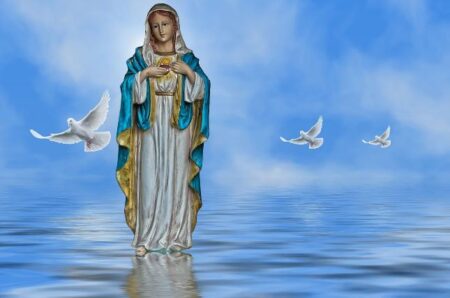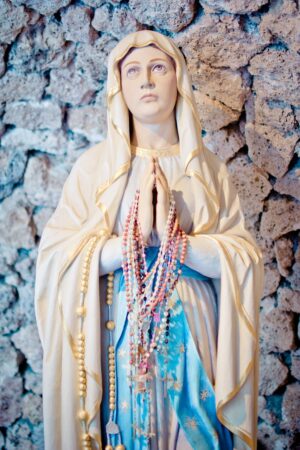
Our Lady of Mercy
To align our reading with the upcoming feast of Our Lady of Mercy I skip to the very last chapter of Cardinal Walter Kasper’s book on Mercy, which is ‘Mary Mother of Mercy’. Ending with a chapter on Mary, as do many Vatican documents, is not meant to be a final flourish, a moment of indulgence and devotion. Mary is integral to catholic theology. She stands within the stream of divine mercy, the divine as related to us and as effecting salvation in and through the human. Mary is at our level. She is our most precious sign of what God is accomplishing in us. As Hopkins says she is ‘our tainted nature’s solitary boast.’
In this short chapter, Kasper does not relate Mary to women’s issues today, though, as we shall see, the question of the feminine is subtly raised by him in terms of the shape of the divine-human communication in the Church. And so a theology of Mary cannot be dismissed as rather ‘high’ and unrelated to daily life. For we must ask what does daily life really need, and what do we ultimately need at a deeply human level? We need the transforming touch of divine grace, and because Kasper’s presentation on Mary evokes the language of grace and faith, it calls for a reading that is meditative and prayerful.
Miriam of Nazareth was a historical figure and Kasper chooses two gospel texts to frame her story: the Annunciation (Lk. 1:26-38) and Mary at the Cross (Jn. 19:26). The young girl Mary was chosen to be part of God’s final decisive stage of mercy and she said ‘yes.’ This ‘yes’ has fascinated theologians down through the centuries with questions such as if God is all, how can the human being have anything to offer? Augustine’s pithy answer is still one of the wisest: ‘the Creator who made us without us does not save us without us.’ Like her forebears, such as Abraham of old, Mary responded to the sheer grace of the divine call and went forth in the obedience of faith. She continued to stand by her Son as the disciple who heard the word of God and put it into practice (Lk. 8:21). And also as the sorrowful mother she stood by him (Stabat Mater) at the Cross. As a mother, it must have grieved her so that this beautiful humanity she gave him should have to suffer so much and be put to death.
Kasper goes on to say that when we come to Church teaching on Mary her greatest title is Mother of God (Theotokos: God-bearer). She is not just mother of Jesus as a human being, but also of Jesus in his humanity as God’s Son. We know that Paul’s post-resurrection theology does not say much about the Jesus of the gospels, nor of Mary, the mother of Jesus, but he has left us with that lapidary statement ‘that in the appointed time God sent his Son, born of a woman.’ (Gal. 4:5). It is as a woman that we find Mary within the admirable commercium of God’s dealings with humanity. Mary as a woman is an integral part of the mystery of God’s dealing with us, and through the centuries, human beings have been creatively expressing this awesome truth. For example, they have seen this space as simply a place to be filled with concrete images of Mary that nourish devotion to her. Kasper lists a number of these well-known images, with some coming from German devotion. But it is interesting to note that he also includes the enigmatic painting accredited to have influenced Pope Francis: ‘Mary the Undoer of Knots’. He attributes the phrase to St. Irenaeus of Lyons who described Mary as the providential figure in the history of salvation who loosed the knot into which Eve had tied us (p.213). And Paul Vallely, biographer of Pope Francis, tells us that when Jorge Mario Bergoglio, SJ was in Germany in 1986, he was a man in turmoil, and the discovery by him of the 1700 c. painting in the church of St. Peter am Perlach in Augsburg was for him a moment of grace. A large copy of this painting now stands in the church of San Jose del Telar in Buenos Aires. More famous now than the original in Germany, it is visited by thousands of people who come to Mary with ‘knots’ of various kinds, trusting that she will unravel them (Paul Vallely, Untying the Knots. Bloomsbury, 2013, p. ixf). Many images of Mary, especially the beautiful Byzantine icons, portray her within the order of grace as the shining forth of the new creation, and as pointing us toward her Son. But the most popular and well known – the Pieta, the Mother of Perpetual Help, the Mater Dolorosa – place her within the stream of God’s relationship to us here and now, within the stream of divine mercy. She is for us as the merciful God is for us; as woman and mother she is a mirror of the divine face turned toward us. In this context, Kasper throws out a sentence, though he does not develop it at length: as a woman and mother figure with her special place in the history of salvation she is a critique of a pure male Church (p. 210). We may surmise here that what he means is that Mary critiques a Church and indeed a Christian way of life that is purely functionalist and without soul, a place of hectic bustle, alienated from itself and without rest, indeed without contemplation. But it would be a false interpretation to say that what is praised here is the pure passivity of Mary, something our Marian spirituality promulgated in the past, to the detriment of women. Mary as a woman is a concrete flesh and blood symbol of what is needed for redemption to take place in all of us and in the world. Hers is an active receptivity to the Good News. We must never forget that she did say ‘yes.’

In an interesting comment on the text of Jn. 19:26f. where the disciple John takes Mary to himself, Kasper, following Augustine, invites us to read it as: he took her ‘into his own’ (p.211). John did not take her as just his possession or responsibility, but also took her with him as needing her in ‘in his sphere of activity.’ Since the figure of John represents the calling of all of us to live as disciples until Christ comes again (Jn. 21:22), so Mary, like her Son is not confined to the past, but is active in the Church here and now as witness to and instrument of divine mercy. Mary’s presence is a kind of ambience or air that Catholicism breathes. The convert poet, Hopkins, was entranced by this presence. He addresses it in his poem on Mary as:
Wild air, world-mothering air,
Nestling me everywhere,. . .
And at the end of the poem he turns to her in prayer. We gather from letters to friends at that time that the poet was feeling ‘jaded.’ He mentions suffering from ‘having no prospect of ever doing much not only in poetry but in anything at all.’ And we may surmise that like a son to a mother he turned to her to untie the knots of his unhappiness. I invite you also to entrust yourself to Mary with his prayer:
Be thou then, O thou dear
Mother, my atmosphere;
My happier world, wherein
To wend and meet no sin;
Above me, around me lie
Fronting my forward eye
With sweet and scarless sky;
Stir in my ears, speak there
Of God’s love, O live air;
Of patience, penitence, prayer;
World-mothering air, air wild,
Wound with thee, in thee isled,
Fold home, fast fold thy child.
(The Blessed Virgin Compared to the Air We Breathe’ in: GMH: Poems and prose ed. W.H. Gardner, 1963)
Jo O’Donovan rsm
Limerick.


